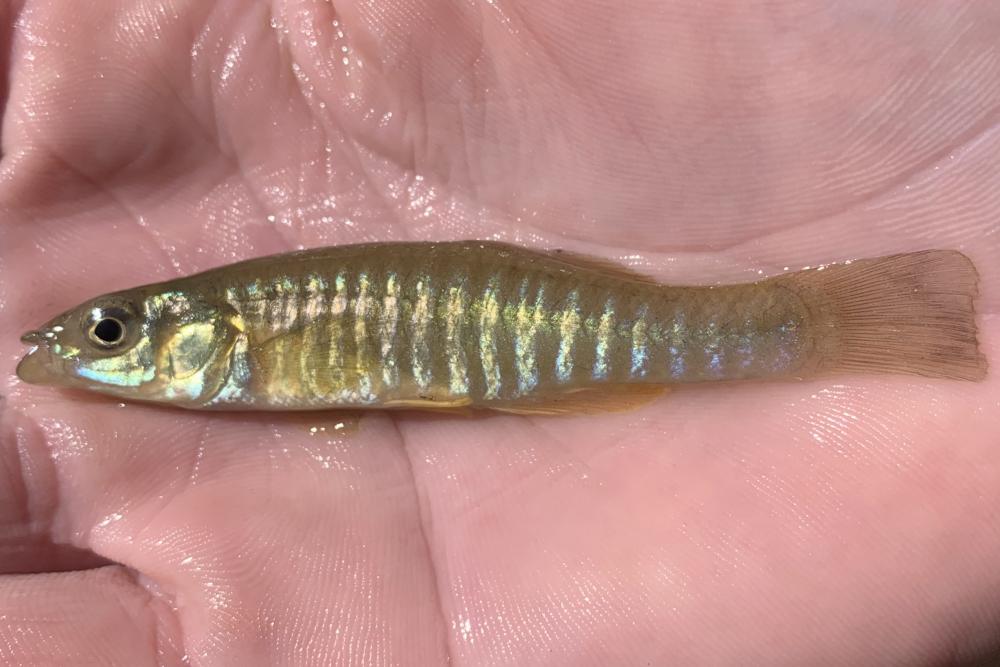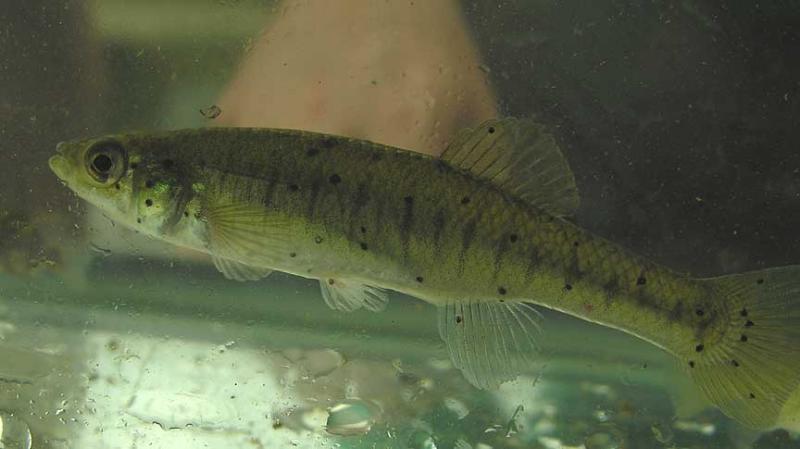The banded killifish or Fundulus diaphanus is a temperate freshwater killifish from North America that belongs to the genus Fundulus and the family Fundulidae. Its native geographic range includes the Great Lakes runoffs and spans from Newfoundland to South Carolina and west to Minnesota.
The only freshwater killifish found in the northeastern United States is this one. Although it is generally a freshwater species, it can be found in brackish water on occasion. The term “banded killifish” refers to the characteristic black and white vertical bandings that run along the sides of the fish.

Body Structure
A top minnow with a thin body and flattened laterally. The mouth is tiny, slanted, and opens dorsally, and the snout is bluntly pointed. It has a protruding lower jaw and bands of very small teeth on both jaws. The dorsal fin contains 10 to 13 rays and is located far back on the back, commencing in front of the anal fin.
There are 9 to ll rays on the anal fin, 6 rays on the pelvic fin, and a rounded caudal fin. The lateral series lacks a lateral line and has 39 to 43 cycloid scales. The back and sides of the body are light olives, while the underside is yellow-white. On the body, there are normally 12 to 20 narrow vertical bars. Adults are typically 2 inches or longer.

The body of the banded killifish is thin and elongate, with a darker dorsal surface and white or yellowish underparts that continue to the anal fin. Males that are about to spawn acquire yellow pectoral and pelvic fins, a vivid blue patch on the anal fin, and beautiful blue iridescence on the lower body, including the area around the anal fin.
The bands in females are usually thin, distinct black bands that do not extend the entire width of the body. Males’ bands are silvery in color, less pronounced, and closer together than females’. A person’s sex can be determined by the number of bands he or she has. The maximum length is 13 centimeters, and the average length is 6.3 centimeters.
Habitats and Distribution
The Banded Killifish frequently congregates in small to large groups, cruising just beneath the surface of weedy lakes. It prefers the shallow waters of glacial lakes and ponds with abundant aquatic vegetation as a habitat. The Banded Killifish can be found in peaceful backwaters near stream mouths, vegetated pools, or stretches of slow-flowing in medium- to large-sized streams over much of its habitat.
It stays away from the cold, fast water of trout streams. Adults are between the ages of 2 and 3. The adults normally move in groups of 3–6, whereas the adolescents usually travel in groups of 8–12. When challenged by predatory fish, the sand and gravel provide hiding places for hatchlings and juveniles. Because the banded killifish is so little, it is usually overlooked.

Since the banded killifish is so little, it rarely travels into deeper waters, where it would be prone to attack and unable to swim against the current. Adult banded killifish, on the other hand, have been spotted feeding in deep bodies of water. Killifish with bands frequently concentrate near aquatic vegetation, which provides both protection and breeding habitat. Although euryhaline, banded killifish prefer to live in freshwater streams and lakes.
The largest adult ever seen was 12.8 cm at Indian Bay, Canada (5.0 in). Fishbait has been made from banded killifish.
The banded killifish is found all over eastern North America, from the Pee Dee River in South Carolina to Newfoundland; it’s also found in southern Pennsylvania, northeastern Nebraska, and the United States Virgin Islands. From Manitoba to Quebec, travel north to the St. Lawrence-Great Lakes and Mississippi River basins.
The Atlantic Slope is home to the eastern subspecies, whereas the rest of the region is home to the western subspecies. The eastern subspecies’ westward growth could be due to bait or aquarium fish introductions into new water bodies, climatic change increasing suitable environment or a high exposure threshold than the western subspecies.
Breeding
Late spring and early summer are prime times for spawning. Spawning takes place in water temperatures ranging from 21 to 23 degrees Celsius. The male chooses a female after courting her. The eggs are discharged in bunches, fertilized, and produce a strand that adheres to aquatic plants fast. Because they perform external fertilization, where the female lays her eggs with sticky threads that adhere to plants, banded killifish are frequently seen spawning in dense aquatic vegetation.
The male selects a location in the shallow water and defends it from other males. When a female appears, the guy will woo her and fight the other male prospectors. While the male pursues her, the female will produce eggs.

